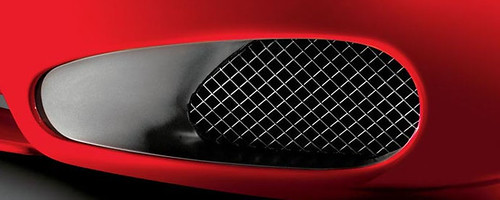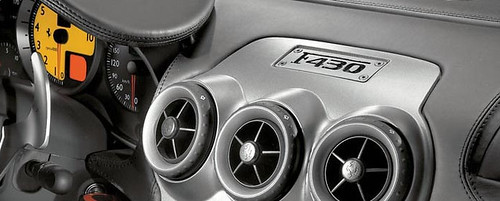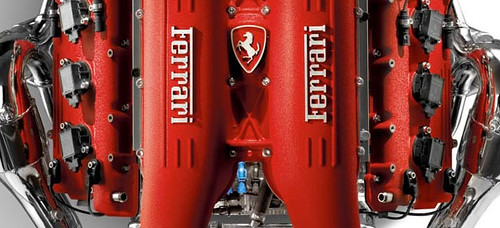The F430 hails the arrival of a whole new generation of Ferrari V8-engined berlinettas. Every inch of the car was inspired by the engineering research carried out at Ferrari's Gestione Sportiva F1 racing division. The result is a highly innovative design characterized by cutting-edge technologies applied for use on a road-going car.
Two of these innovations are world firsts on high-performance sports cars: the electronic differential (E-Diff), originally developed by Ferrari for its F1 single-seaters, and the steering wheel-mounted commutator switch (the manettino) which directly controls suspension settings, the CST stability and traction control, the E-Diff and the change speed of the F1 transmission.
The F430's all-new 4,308 cc engine develops 483 bhp and 465 Nm (343 lb/ft) of torque. Needless to say, performance is outstanding: acceleration from 0 to 60 mph (100 km/h) in 3.9 seconds flat and a maximum speed in excess of 195 mph. As well as an increase in performance. New aerodynamics provide even greater down force, with 616 lbs generated at 186 mph.
Other Ferrari Formula 1 influences can be seen in the optional carbon-ceramic discs, which offer superior stopping power, and the F1 paddle shifter, which effectively halves change times compared to the 360
The F430 comes as standard with new 19" alloy wheels and adaptive suspension in a package that has been designed to deliver outstanding performance and maximum driving pleasure.
Design
The F430's shape, created in collaboration with Pininfarina, is inspired by the car's exceptional engineering. Each and every styling cue highlights the aggression and performance of a thoroughbred Ferrari yet respects the functional demands of this kind of car. In design terms, little has been carried over from the outgoing 360

The F430's nose is characterized by two distinctive air intakes that channel air into generously dimensioned radiators to cool the powerful engine. Their shape draws inspiration from the Ferrari 156 F1 that Phil Hill drove to his F1 World Championship title in 1961. The two intakes are linked at their lower edge by a spoiler that directs air towards the car's flat underbody. The F430's vertically stacked headlights are extremely compact thanks to the use of Bi-xenon technology. When the lights are on, the unique shape of the side light incorporated into the outer edge of the headlight, emphasizes the profile, making the car immediately recognizable even at night. Large air vents just ahead of the front wheels channel the air out of the radiators and along the car's flanks.
The Enzo Ferrari was the inspiration for much of the rear styling of the new F430. The type and arrangement of the lights are the same with the latter protruding prominently from the bodywork. Another similarity is the shape of the air vent for the engine with the chrome Prancing Horse at its center.

Extreme care was also lavished on designing the exterior details. The side mirrors, for example, now have specially profiled twin mounting arms that channel airflows to the engine intakes. The F430 name has also been embossed on the back of the driver's side mirror.
Interior
The F430's interior has been redesigned for improved driver ergonomics. The instruments are housed in a new binnacle, and this design together with the layout of the dashboard underlines the care that has gone into grouping all the major controls in front of the driver within easy reach. The same uncompromising approach to driver control was the inspiration behind mounting the starter button and manettino on the steering wheel.

The interior reflects the advanced technology and materials employed in the car's construction, and can be personalized with carbon-fiber or aluminum inserts. The cockpit is noticeably larger. Already excellent passenger comfort is improved thanks to a slimmer central tunnel which houses the gear lever turret on the manual version and the F1 console on the paddle-shift version. There is additional space behind the rear seats, with a new electrically operated compartment for storage and catch netting to the rear fire wall. The seats have been redesigned for greater lateral containment and by a sporty race-derived seat with supportive side bolsters.
The Carrozzeria Scaglietti personalization program is Ferrari's way of ensuring that its relationship with each of its clients is absolutely unique. The program offers F430 owners a range of racing and styling features and personalized finishes so wide that the possible combinations are virtually limitless. A total of 16 bodywork colors, 12 leather colors and eight colors for the carpets are available. The personalization options are divided into four main areas: Racing and Track, Exteriors and Colors, Interiors and Materials, Equipment and Travel.
Technical
The F430 is powered by a new 90° V8 featuring Ferrari's traditionally uncompromising design approach with a flat-plane crank (180° between throws). This is an all-new unit that does not share any components with the 360
One of the technical features that sets the F430 apart is the E-Diff or electronic differential. This solution is used for years in F1 single-seaters and has been continuously developed and refined, effectively transferring massive torque levels to the track under extremely high cornering g-forces. The E-Diff is now standard equipment on the F430 - the first time that a production car has been equipped with such a sophisticated system for high-performance road holding. On the track, the E-Diff helps provide maximum grip out of turns designed to eliminate wheel spin.

Just like in Formula 1, the F430 driver can change the set-up of his car using the innovative selector set on the steering wheel. The manettino is a rotary switch that has been adopted directly from racing, where the driver's total commitment to driving requires maximum efficiency and speed in controlling the car's various functions. This switch quickly and simply controls the electronics governing suspension settings, the CST stability and traction control, E-Diff and the change speed of the F1 transmission, as well as the integration between each of these individual functions.
